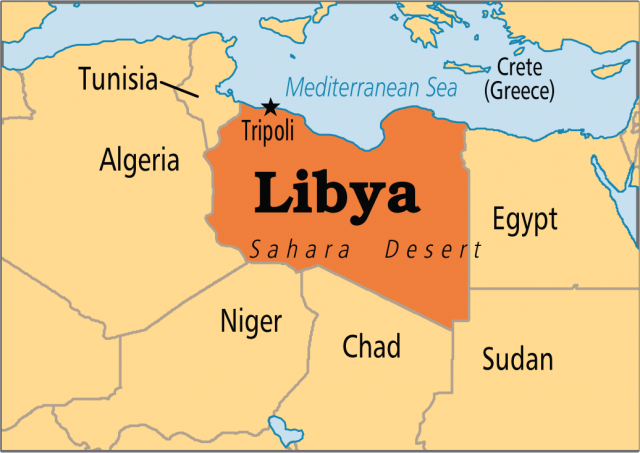Libya
Area 679,362 square mi (1,759,540 square km)
Population 6.259 million (2014)
Capital Tripoli
Highest Point 7,437 ft (2,267 m)
Lowest Point -154 ft (-47 m)
GDP $41.12 billion (2014)
Primary Natural Resources crude oil, petroleum products.
A RELATIVELY LARGE country, similar in size to the state of ALASKA, Libya largely consists of broad rolling deserts, barren rock inselbergs and immense dune fields or ERGS. It is a landscape of sandstorms; hot dusty wind, or ghibli; an expanding desert; and scarce water. More than 90 percent of the country is considered arid or semiarid. It primary cities are all located on the MEDITERRANEAN SEA coastline, which has facilitated its links across North Africa to Europe and western Asia.

Generally speaking, the Saharan plateau covers most of Libya. The exceptions are in the northwest corner in a region known as Tripolitania and in the northeast in Cyrenaica, Libya's largest region. The Tripolitania region, which runs north to south, is a string of carefully cultivated coastal oases in addition to the triangular Al-Jifarah plain, and the Nafusah Plateau, 200 mi (320 km) of limestone between 2,000 and 3,000 ft (600 to 915 m) in elevation.
Libya has no perennial rivers, but there are extensive underground aquifers that support artesian wells and springs. Libya's arid desert climate is moderated along the coast by the Mediterranean Sea. Precipitation ranges from 16 to 20 in (40 to 50 cm) in the northern hills to less than 5 in (12 cm) throughout most of the south, and to 1 in (2.5 cm) in the Libyan Desert. Droughts are common, meaning natural vegetation is minimal. Libya's principal mineral resource is its reserves of petroleum, Africa's largest and among the world's largest.
Since it earliest days as a major Phoenician and Roman territory on the North African coast of the Mediterranean Sea, Libya has been raided and colonized by Vandals, Arabs, Ottoman Turks, and Italians until its independence in 1951. Only a few years later, the country changed dramatically with the discovery of enormous oil reserves. In 1969, a 27-year-old Muammar Qaddafi led a successful coup to gain control of the nation. Qaddafi has been victorious in removing any imprints of previous cultures to create a landscape from his own vision. Based upon his Third International Theory, he created a political system combining Islam and socialism.
Using petroleum revenues in the 1970s and 1980s to promote political ideologies (including supporting terrorist activities) throughout the region, Libya prompted the United Nations (UN) to impose economic sanctions after the Lockerbie terrorist bombing was suspected to have had Libyan ties. The sanctions were then lifted in April 1999 when Qaddafi handed over Lockerbie bombing suspects.